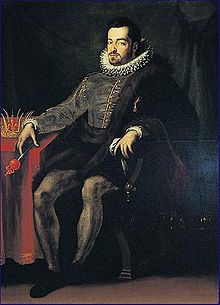Ferdinando I de' Medici, Grand Duke of Tuscany
| Ferdinando I | |||||
|---|---|---|---|---|---|
 |
|||||
| Grand Duke of Tuscany | |||||
| Reign | 19 October 1587 – 7 February 1609 | ||||
| Predecessor | Francesco I | ||||
| Successor | Cosimo II | ||||
| Born |
30 July 1549 Florence |
||||
| Died | 17 February 1609 (aged 59) Florence |
||||
| Spouse | Christina of Lorraine | ||||
| Issue | |||||
|
|||||
| House | Medici | ||||
| Father | Cosimo I de' Medici, Grand Duke of Tuscany | ||||
| Mother | Eleanor of Toledo | ||||
| Full name | |
|---|---|
| Ferdinando de' Medici |
Ferdinando I de' Medici, Grand Duke of Tuscany (30 July 1549 – 17 February 1609) was Grand Duke of Tuscany from 1587 to 1609, having succeeded his older brother Francesco I.
Ferdinando was the fifth son (the third surviving at the time of his birth) of Cosimo I de' Medici, Grand Duke of Tuscany and Eleanor of Toledo, the daughter of Don Pedro Alvarez de Toledo, the Spanish viceroy of Naples.
He was made a Cardinal in 1562 at the age of 14 but was never ordained into the priesthood. At Rome, he proved an able administrator. He founded the Villa Medici in Rome and acquired many works of art (including the Medici lions), which he then brought back to Florence with him.
When his brother Francesco I de' Medici, Grand Duke of Tuscany died in 1587, Ferdinando succeeded as Grand Duke at the age of 38.
In many ways, Ferdinando was the opposite of his brother who preceded him. Approachable and generous, he set out to rule mildly. He re-established the justice system and was genuinely concerned about the welfare of his subjects. During his reign, Tuscany revived and regained the independence his brother had given up.
Ferdinando fostered commerce and gained great wealth through the Medici banks, which were established in all the major cities of Europe. He enacted an edict of tolerance for Jews and heretics, and Livorno became a haven for Spanish Jews as well as other persecuted foreigners. He established the Medici Oriental Press (Typographia Medicea), which published numerous books in the Arabic script.
He improved the harbor Cosimo I had built and diverted part of the flow of the Arno River into a canal called the Naviglio, which aided commerce between Florence and Pisa. He fostered an irrigation project in the Val di Chiana, which allowed the flatlands around Pisa and Fucecchio and in the Val di Nievole to be cultivated.
...
Wikipedia
